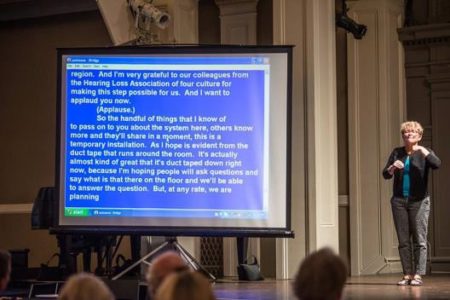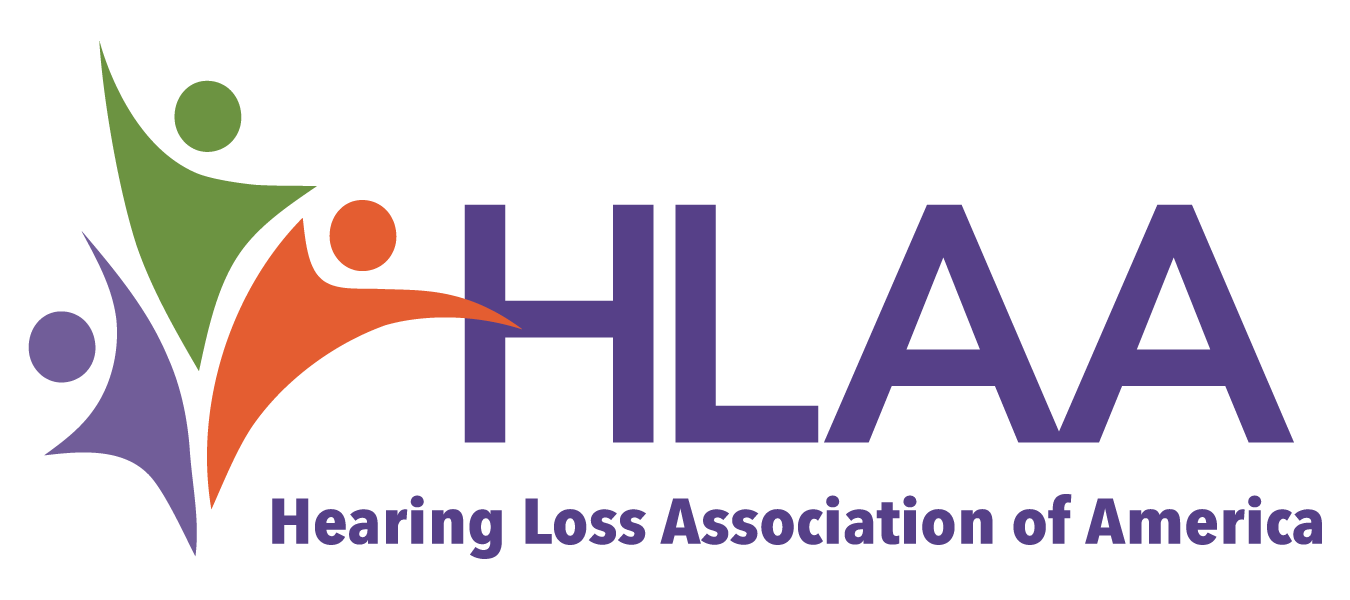Captioning
Captions are words displayed on a television, computer, mobile device, or movie screen, providing the speech or sound portion of a program or video via text. Captions allow viewers to follow the dialogue and the action of a program simultaneously. For people with hearing loss who have residual hearing, captions can make the spoken words easier to understand—because hearing, like vision, is influenced by our expectations. (When you have an idea of what someone might be about to say, his or her speech may seem more clear). Captions can also provide information about who is speaking or about sound effects that might be important to understanding a news story, political event, or the plot.
Captions are created from the program’s script or audio file. A caption writer translates the dialogue into captions and makes sure the words appear in sync with the audio. Computer software encodes the captioning information and combines it with the audio and video to create a new master tape or digital file of the program. The captions should appear near the bottom or top of the screen—not in the middle, where misplaced captions can cover the newscaster’s face, a basketball hoop or a quarterback passing the football.
A caption writer (sometimes trained as a court reporter or stenographer) uses a stenotype machine with a phonetic keyboard and special software. A computer translates the phonetic symbols into English captions almost instantaneously. The slight delay is based on the captioner writer’s need to hear and code the word, and on computer processing time. Pre-recorded programming (television shows, movies, documentaries) all should been seen with no errors at all. Although real-time captioning strives to reach 98 percent accuracy, the audience will see errors. The caption writer may mishear a word, hear an unfamiliar word, or have an error in the software dictionary. In addition, transmission problems can create technical errors that are not under the control of the caption writer. Real-time captioning can be used for programs that have no script; live events, including congressional proceedings; news programs; and non-broadcast meetings, such as the national meetings of professional associations.
Open and closed captions
Captions may be “open” or “closed.” Open captions are always in view and cannot be turned off by the user, whereas closed captions can be turned on and off by the user (for example, by changing the menu settings on the TV’s remote).
Closed captioning is available on digital television sets, including high-definition television sets, manufactured after July 1, 2002. Some digital captioning menus allow the viewer to control the caption display, including font style, text size and color, and background color.
Closed captioning is also available on videos viewed on the internet.
Electronic newsroom captions
Electronic newsroom captions (ENR) are created from a news script computer or teleprompter and are commonly used for live newscasts. Only material that is scripted can be captioned using this technique. Spontaneous commentary, live field reports, breaking news, and sports and weather updates usually are not captioned using ENR; therefore, real-time captioning is preferred.
Enhanced ENR attempts to bridge that gap, by electronic captioning of scripted in-studio produced programming, weather information, and pre-produced information and supplementing non-scripted live interviews and/or breaking news segments with crawls or textual information.
Edited and verbatim captions
Captions can be produced as either edited or verbatim captions. Edited captions summarize ideas and shorten phrases. Verbatim captions include all of what is said. Although there are situations in which edited captions are preferred for ease in reading (such as for children’s programs), most adults prefer the full access provided by verbatim texts.
Theater captioning
Movie Theaters
Theaters that show digital first run movies will offer an assistive device for an individual to see the captions, such as captioned glasses or a caption device that fits in a cup holder. Some movie theaters also offer open captions that appear on the screen so everyone can see them at pre-scheduled times. Movies that still show 35 millimeter films and drive-in movie theaters are not required to provide captioning devices.
U.S. Department of Justice rules require movie theaters to provide closed captioning, with some exemptions. Open captions are not required but some theaters have scheduled showings with open captions.
Live Theater
Theaters must provide effective communication under the Americans with Disabilities Act of 1990. This can be an assistive listening system such as a hearing loop or infrared system. Captioning might be also be provided with captions scrolling on a display on stage or on a hand-held device.
Captioned telephone
A captioned telephone has a built-in screen to display the text of what the person is saying on the other end of the line. The person with hearing loss places the outgoing call on a captioned telephone and the call is connected to a Captioned Telephone Service (CTS). A specially-trained CTS operator hears the person talking, repeats what that person says and speech recognition technology automatically transcribes the CTS operator’s voice into text that is displayed on the captioned telephone screen. The person with hearing loss can read the text of the call as well as listen to the call and using residual hearing.
CTS may also be provided via an internet connection (IP CTS). IP CTS may be displayed on an IP CTS telephone or via an application downloaded to a cell phone, tablet or other mobile device.
The law
The Americans with Disabilities Act (ADA) of 1990 requires businesses and public accommodations to ensure that individuals with disabilities are not excluded from or denied services because of the absence of auxiliary aids or services. Captions are considered one type of auxiliary aid. Since the passage of the ADA, the use of captioning has expanded. Entertainment, educational, informational, and training materials are captioned for deaf and hard-of-hearing audiences at the time they are produced and distributed.
The Television Decoder Circuitry Act of 1990 requires that all televisions larger than 13 inches sold in the United States after July 1993 have a special built-in decoder that enables viewers to watch closed-captioned programming. The Telecommunications Act of 1996 directs the Federal Communications Commission (FCC) to adopt rules requiring closed captioning of most television programming.
Twenty-First Century Communications and Video Accessibility Act of 2010 updates federal communications law to increase the access of persons with disabilities to modern communications. The CVAA makes sure that accessibility laws enacted in the 1980s and 1990s are brought up to date with 21st century technologies, including new digital, broadband, and mobile innovations.
Captions and the FCC
The FCC’s rules on closed captioning became effective January 1, 1998. They require people or companies that distribute television programs directly to home viewers to caption those programs. The rules required all nonexempt programs to be closed captioned by January 1, 2006; after that date, captioning was also required for all new nonexempt programs. As of January 1, 2010, all new nonexempt Spanish language video programming must also be provided with captions.
The 21st Century Video and Communication Act of 2010 updated those rules. Under the CVAA, programs shown on television with captioning are required to include the captioning when they are re-shown on the internet. Detailed guidelines and definitions of terms are available in the FCC’s Electronic Code of Federal Regulations.
Who is required to provide closed captions?
Congress requires video program distributors (cable operators, broadcasters, satellite distributors, and other multichannel video programming distributors) to close caption their TV programs. FCC rules ensure that viewers have full access to programming, address captioning quality, and provide guidance to video programming distributors and programmers. The rules require that captions be accurate, synchronous, complete, and properly placed. In addition, the rules distinguish between prerecorded, live, and near-live programming, and explain how the standards apply to each type of programming, recognizing the greater challenges involved with captioning live or near-live programming.
What programs are exempt?
Some advertisements, public service announcements, non-English-language programs (with the exception of Spanish programs), locally produced and distributed non-news programming, textual programs, early-morning programs, and nonvocal musical programs are exempt from captioning.
To find out more about the FCC rules and captions, including information on the complaint process, call:
Toll-Free Voice: 1-888-CALL-FCC (1-888-225-5322)
Toll-Free TTY: 1-888-TELL-FCC (1-888-835-5322)
CART – Communication Access Realtime Translation
You’ve seen captions on television shows, Netflix, and in movie theaters. CART works in a similar way, transcribing and translating spoken text and sound into words. The text appears in realtime —while the words are spoken or played — on a big screen that everyone can see, on a laptop, or on a mobile device. Remote CART can also be streamed to an Internet browser.
CART helps make your event, speech, courtroom, classroom, workshop, seminar, church service, or meeting compliant with the Americans with Disabilities Act (ADA) and accessible to people who have a hearing loss. Hearing accessible technology and services are crucial to creating an inclusive event so that everyone can participate, regardless of how well they hear. When possible, an audio component should be considered as well: hearing assistive technology such as induction loops, FM, and infrared systems combined with CART provide the highest level of accessibility.
Even people with good hearing sometimes struggle to comprehend completely, especially in loud or noisy environments. CART helps those people, too, as well as people for whom English is a second language. And for people with significant difficulties hearing, CART can mean the difference between staying home and staying engaged.
The text can be projected onto a screen, displayed on a computer monitor or laptop, or transmitted via the internet. People who need CART, and event and venue managers, should be aware that CART can be combined with PowerPoint or other presentation content—enabling people to view all content on one screen.
We offer the following guidance to help you create and develop the most effective and accurate CART for your event.
Planning for CART and Effective Communication

- Select an experienced CART writer. Check to be sure the CART writer is a Certified Realtime Captioner with this certification: CRC. People who pass the CRC skills test provided by the National Court Reporters Association (NCRA) will have the high level of skill and accuracy needed to provide real-time, professional CART writing specifically designed to ensure that people who are deaf or hard of hearing have a full understanding of the event or proceeding. Also, be sure to check the CART writer’s resume to determine whether the individual has a background and experience adequate to match the demands of the job.
- Consider audio hearing access technology: hearing loops, FM, or infrared. It can be challenging and fatiguing to read every captioned word; both audio and visual solutions create the ideal.
- Send the CART writer copies of presentation materials (Powerpoint presentations, handouts, speeches) as much in advance as possible. This is especially crucial for names and technical terms that need to be correct and spelled properly. Consider sending the caption writer a glossary, bibliography, or staff/attendee list. If you have one, send the room layout chart.
- Clarify that you want CART on large screen when viewed by many people. Remember that several people huddled around a laptop is not the ideal solution and may leave out others who would benefit.
- Consider the best way to place screens for optimum viewing by the greatest number of people. Think “clear sight lines.”
- Make sure the caption writer is admitted to the event without admission fees and with early access to set up.
- The caption writer will need a table, reserved space (near the front), an electrical outlet and extension cord, and safety tape to secure the cord.
CART Just Before the Event
- Make sure the display is visible to as much of the audience as possible.
- Make sure the font is large enough and stands out from the background.
- Make sure at least two lines show on each display, and that the captions remain visible long enough to be read.
- Test the display methods from each place in the room that someone may need to read them.
- Cover cords with tape so guests don’t trip.
- Coach speakers to speak slowly, pause periodically, and enunciate carefully.
- Coach panelists to make sure one person speaks at a time, and to take breaks as needed.
- Provide tabletop name cards to presenters or panelists, if possible.
CART During the Event

- Monitor caption quality. Be confident in interrupting the speaker to ask that they stay near the microphone, speak more slowly, etc. Watch for repeated “inaudible” instances in the captions.
- Use a high quality sound system when possible. Remember that the caption writer must be able to hear clearly. Whenever possible, offer a direct feed to the caption writer via headphones.
See more about CART in action in this YouTube video.

